Birds
Little Cormorant
Local Name: .jpg) Kakkattaravu
Kakkattaravu
Size: Somewhat larger than the Jungle Crow, with longer neck and tail.
Field Characters: A glistening black duck-like water bird with a longer stiff tail and slender compressed bill sharply hooked at the tip. A small white patch on throat, and suggestion of a nuchal crest. Sexes alike. Singly or in flocks, on or near water.Cormorants are almost exclusively fish-eaters. They chase and capture their quarry under water, being expert divers and submarine swimmers. Flocks sometimes hunt in concert in the manner of pelicans. They also hunt individually. When satiated, the birds may be seen sitting on a rock or sandbank, or on stakes or trees in or near the water, drying themselves with outstretched wings.
Eggs: 4 or 5, long narrow ovals, bluish white in color with a chalky texture.
Average Size: 44.8x29.0mm
Indian Darter or Snake –Bird
Local Name: Chera-Kozhi
Size: About that of the Kite
Field Characters: A black, cormorant-like water bird with a long and very slender S-shaped neck, narrow head and pointed dagger bill. Back heavily streaked with silver-grey; head and neck velvety brown; chin and throat whitish. Tail long, stiff and wedge-shaped(almost rounded). Sexes alike. Singly or in loose parties on tanks. Resident. Fairly common, but not abundant. Affects open placid streams, village tanks, and dammed reservoirs. On the last the exposed tops of the submerged dead tress provide favorite lookout and wing-drying posts. This is also found in Ceylon , all India, Burma, Malaysia, Indochinese countries to the Phluppines. Other races occur in America, Africa and Australia .
Eggs: 3 or 4, very elongated,pale greenish blue with whitish chalky coating.
Average size: 52.9x33.5mm
Eastern Grey Heron 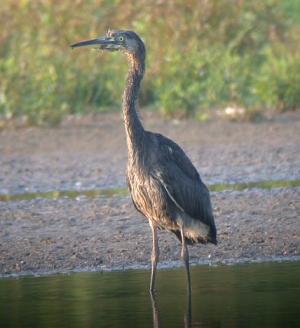
Local Name: Charamunti
Size: About the same as the Purple Heron
Field Characters: Like the Purple Heron but ashy grey above with white crown and neck; grayish white below. Long black occipitai crest. Elongated white feathers on the breast with some black streaks. A conspicuous black dotted line down the middle of the fore neck. In the female the crest and pectoral plumes are less developed. Solitary, on reedy marshes. Distributed outside Berala is in Ceylon, all India, Burma, Malaysia . This race ranges from Iraq eastward to the Philippines.The species overall is found throughout the old World.
Eggs: Almost indistinguishable from those of the Purple Heron.
Average size: 58.6X43.5 mm.
Indian Littile Green Bittern
Local Name: Chinna-kokku.
Size: About the same as, or slightly smaller than, the Pond Heron.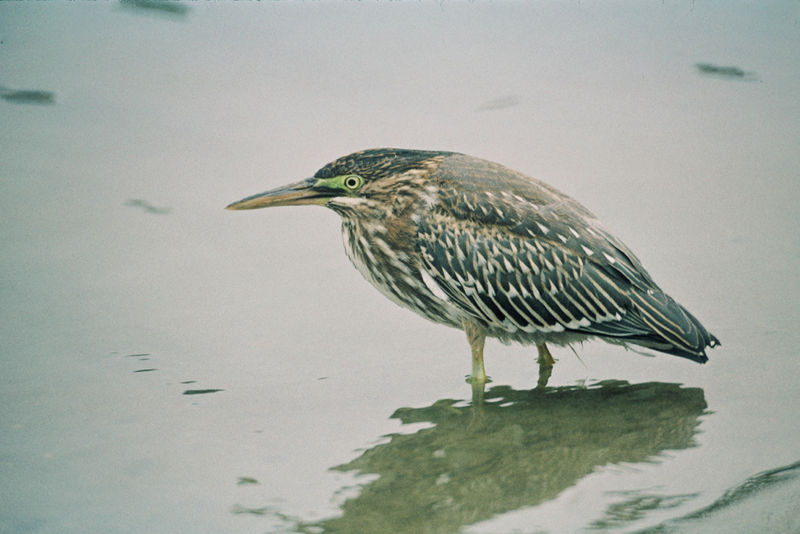
Field Charaters: Like the Pond Heron in general effect but largely blackish grey, glossy dark green and bronze-green above; ashy grey below. Top of head and long occipital crest black, glossed with dark green. Chin and throat white. Sexes alike. Solitary, in screwpine thickets and brushwood near water.Resident. Not common. Low country, and to at least 2000 ft. (c. 600 m). Keeps to brushwood in and on the banks of rocky streams. Distributed outside Kerala is in Ceylon, India, Burma, Thailand, South China, Malaysia.The species in numerous races is practically cosmopolitan.
Eggs: 3 to 5, very like the Pond Heron's.
Average size:39.5X29.7 mm
Indian Pond Heron, or Paddy Bird
Local Name: Kulamunti, Kulakokku.
Size: Slightly smaller than the Cattle Egret. About that of a village hen.
Field Characters: An egret-like marsh bird, largely snow-white but effectively obliterated while at rest by a 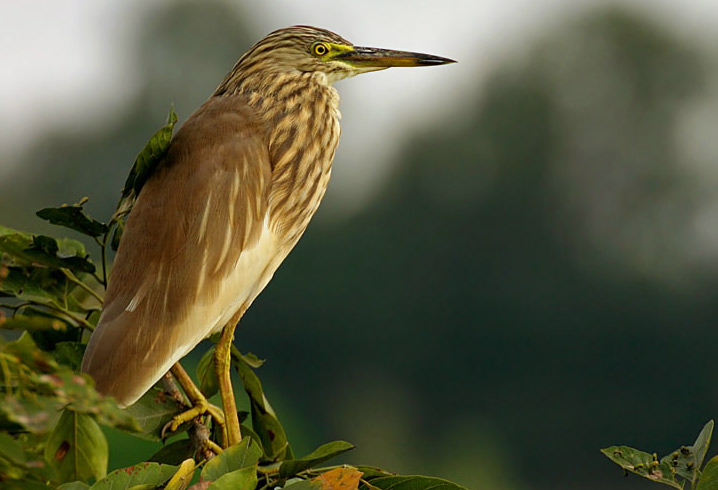 camouflaging earthy-brown mantle. In the breeding season a bunch of filamentous maroon hair-like plumes covers the back, and a long white occipital crest adorns the head. Sexes alike. Singly or in loose parties, at streams, tanks and puddles. The food of the Pond Heron consists mainly of frogs, fish, crabs and insects. Resident. Common. Low country, and up to at least 3000 ft.(c. 900 m.) ( Periyar Lake and environs). Affects streams, tanks, inundated paddy fields, flooded ditches, by the coastal backwaters as well as inland. Distributed outside Kerala is in all India, Burma, Thailand, Malaysia, .West to the Persian Gulf . A different race (phillipsi) in the Maldive Islands .
camouflaging earthy-brown mantle. In the breeding season a bunch of filamentous maroon hair-like plumes covers the back, and a long white occipital crest adorns the head. Sexes alike. Singly or in loose parties, at streams, tanks and puddles. The food of the Pond Heron consists mainly of frogs, fish, crabs and insects. Resident. Common. Low country, and up to at least 3000 ft.(c. 900 m.) ( Periyar Lake and environs). Affects streams, tanks, inundated paddy fields, flooded ditches, by the coastal backwaters as well as inland. Distributed outside Kerala is in all India, Burma, Thailand, Malaysia, .West to the Persian Gulf . A different race (phillipsi) in the Maldive Islands .
Eggs: 3 to 5, pale greenish blue.
Average size: 38.0X28.5 mm.
Cattle Egret
Local Name: Kalimunti 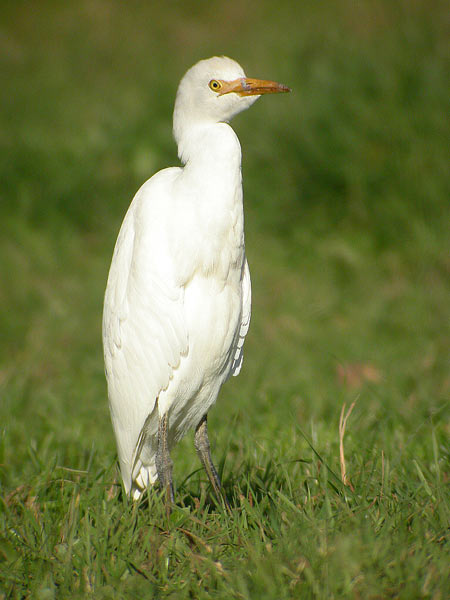
Size: Same as the Little Egret. About that of the domestic hen; lankier and more leggy.
Field Characters: Snow-white overall, very similar to the Little Egret, with which it may sometimes be confused. But the colour of its bill-yellow (instead of black) – is always diagnostic. In the breeding season the head, neck and back turn a distinctive golden, orange-buff. Sexes alike. Flocks, attending on grazing cattle. Resident (presumably). Apparently much more abundant in Ferguson 's day than at present, but still the commonest of all the egrets. Frequents paddy fields along the backwaters, cultivated and fallow land, chiefly in attendance on grazing cattle. Distributed outside Kerala is in Ceylon, all India, Burma, Thailand, Malaysia to the Philippines and Eastern China.The nominate race occurs in Africa, S.Europe and W.Asia. Its food consists very largely of bluebottle flies picked off the grass or weeds. The bird poises its bill, sways its neck comically from side to side to get a correct aim, as it were, and jabs at the quarry. Grasshoppers and other insects, as well as frogs and lizards, are also eaten.
Eggs: 3 to 5, pale skim-milk blue in colour, unmarked.
Average size: 44.1X33.6 mm.
Eastern Grey Heron
Local Name: Perumunti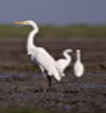
Size: About the same as, or slightly smaller than, the Grey Heron.
Field Characters: A large, lanky, snow-white, heron-like marsh bird with bare blackish legs, long slender neck and head, and pointed black or yellow bill. In the breeding season a bunch of ornamental filamentous plumes (‘aigrettes') develops on the back, falling over beyond the tail. No crest or breast plumes. Sexes alike. Solitary, on marshes and tanks. Resident. Uncommon. Frequents waterlogged paddy stubbles, reedy islets and mud-banks in the coastal backwaters. Distributed outside Kerala is in Ceylon, all India, Burma, Malaysia, Indochinese countries to Japan and Australia. Its food-insects, frogs, fish, small reptiles.It is procured in shallow water or from the squelchy mud.
Eggs: 3 to 4 , very like those of the Grey and Purple Herons, but somewhat smaller.
Average size: 54.0X38.6 mm.
Indian Smaller Egret
Local Name: Cherumunti 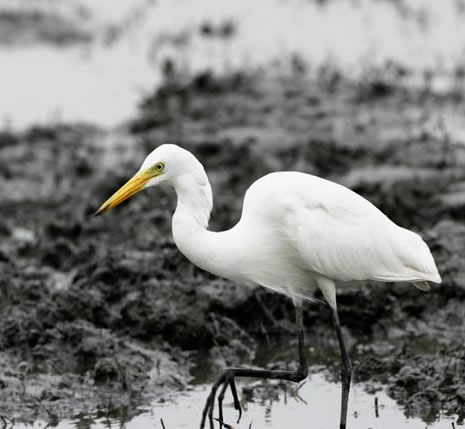
Size: Slightly smaller than the Large Egret.
Field Characters: Somewhat smaller, but otherwise very like the Large Egret and easily confused with it. Differentiation more satisfactory in breeding plumage, when it has decomposed ornamental plumes on both back and breast. No crest. Sexes alike. Solitary, or in small parties at marshes. Resident. Fairly common but not abundant. Frequents the coastal backwaters, as well as tanks and inundated paddy cultivation inland. Much persecuted by local shikaris and as a rule inordinately wary everywhere. Distributed outside Kerala is in CeylonCeylon, all India, Burma, Malaysia, Indochinese countries to Japan and the Philippines .
Average size of Egg: 47.6x35.8mm.
Little Egret
Local Name: Chinnamunti. 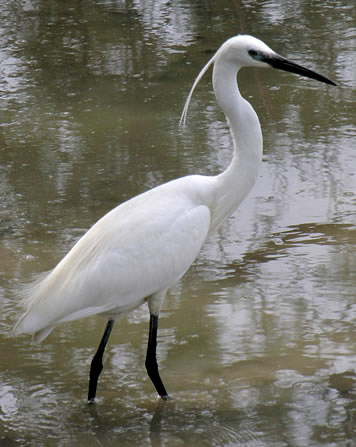
Size: Smaller than the last. About that of a domestic hen,with longer legs and neck.
Field Characters: A lanky snow-white marsh bird- a smaller edition of the Large Egret. In the breeding season it develops a long drooping crest of two narrow plumes, in addition to filamentous ornamental feathers(airgrettes) on both breast and back. Bill black at all seasons. Feet particoloured yellow and black. Sexes alike. Flocks, on marsh land. Resident, Commoner that the lat two, but not abundant. Frequents the backwaters,inundated and waterlogged cultivation, tanks, streams. Distributed outside Kerala is in Ceylon, all India, Burma, Malaysia to China and Japan . Also Europe, Africa and W. Asia .
Eggs: 3 to 5, of the usual blue-green colour.
Average size: 44.4X31.7 mm.
Indian Reef Heron
Local Name: Tiramunti 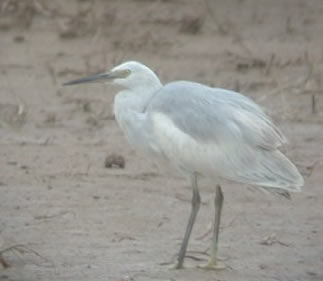
Size: About that of the Little Egret.
Field Characters: General effect as of the Little Egret, also with particoloured feet, but found in two colour phases: 1) pure white, 2) bluish slate with a white patch on throat. Occasional examples are intermediate, being partly white and partly slaty. A backwardly drooping crest of two narrow plumes is acquired in the breeding season.The white phase is easily confused with the Little Egret, but its more solitary habit and seacost habitat usually distinguish it. Sexes alike. Resident. Not common. Frequents the coastal backwaters, keeping to the waterline on mud-banks, or perched on stones or fishing stakes in shallow water. Rarely inland; once near Coimbatore (Pillai, 1959, JBNHS 57 (1): 222). Distributed outside Kerala is in Ceylon and up along the western coast of India to the Persian Gulf . Also the Laccadive Islands . Fish, particularly the mud-crawler (Periopthalmus), crustaceans and molluscs are the principal food items.
Eggs: 3 or 4, pale sea-green or blue-green, unmarked.
Average size: 44.9X34.3 mm.
Night Heron
Local Name: Toppi-kokku, pathirakokku .jpg)
Size: Larger than the Pond Heron; about that of the Kite.
Field Characters: A stocky egret-like bird of the same general effect as the Pond Heron but with a stouter bill. Ashy grey abive with glossy greenish-black back and scapulars. Crown, nape and long occipital crest black, the last with some white feathers intermixed. Young birds brown, streaked and speckled with rufous and dark brown-rather similar looking when at rest to the Pond Heron in non-breeding plumage. Sexes alike. Loose flocks, roosting in bushes by water during day; flying out to feed at dusk with a loud raucous kwaark or wock. Resident. Not common. Low country (Vembanad Lake). Distributed outside Kerala is in Ceylon , all India , Burma , Malaysia to the Philippines . Westward to N. Africa , S. and C. Europe. The food and other habits do not differ from those of other herons and egrets.
Eggs: 4 or 5, pale sea-green.
Average size: 49.9X35.1 mm.
Openbill Stork
Local Name: Cherakokkan
Size: Smaller than vulture. Long legged; standing about 2 1/2 ft. (75 cm.) high. 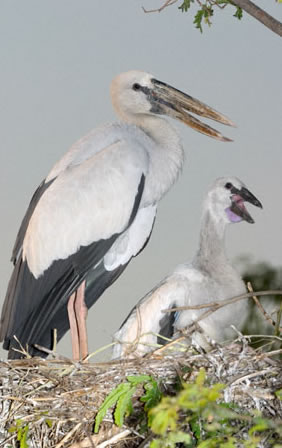
Field Characters: A small stork of grayish white or white plumage, with black in the wings. The curious reddish black bill, with arching mandibles leaving a narrow open gap between them, is diagnostic. Sexes alike. Twos and threes or flocks, at tanks and marshes. Resident. According to Ferguson (1904, JBNHS 16: 15 ) 'very common in Travancore where large flocks may be met with on the marshy borders of all the larger tanks and freshwater lakes, sharing the trees for roosting with flocks of Darters'. Since then its status in Kerala seems to have altered considerably. It is now found only sparsely and in small numbers. Distributed outside Kerala is in Ceylon , all India , Assam , Burma , Thailand and Cambodia . It is apparently adapted in some way to deal with the thick hard shells of the large Pila snails found on marshes, the soft body and viscera of which form such an important food item of this species. It also eats frogs, crabs, large insects.
Eggs: 2 to 4 , sullied white.
Average size: 57.9X41.2 mm.
Whitenecked Stork
Local Name: Karim-kokku,Karavarakuru
Size: About that of the Vulture; standing about 3 ft.(90cm) high.
Field Characters: A glistening metallic black strok with conspicuous white neck and black ‘skull cap'. Lower abdomen and under tail –coverts white. Long bare red legs. Heavy pointed black bill. Sexes alike. Singly, pairs or parties in damp fields. Resident. Affects sandbanks in rivers, damp paddy stubbles, in the low country, singly or in small parties. The edges of the newly formed dammed reservoirs in the state afford attractive feeding. Distributed outside Kerala is in Ceylon , all India and Burma , Malaysia and east to Celebes . Another subspecies is found in Africa.The birds walk about sedately and jab at their prey, which consists mainly of frogs, fish, reptiles, water-beetles and large insects. Storks have no voice-producing mechanism and are therefore silent birds except for a loud clattering or clapping of the mandibles sometimes indulged in.
Eggs: 3 or 4, white, obtuse ovals.
Average size: 62.9X47.4 mm.
White Ibis
Local Name: Kashanti-kokku.
Size: About that of a large domestic hen.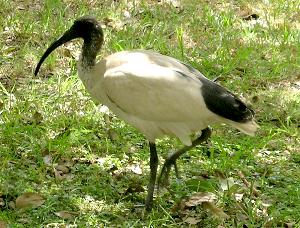
Field Characters: A large white marsh bird with naked black head and neck and long, stout, black, down curved curlew-like bill. In the breeding season there is some slaty grey on the scapulars and inner secondaries. Elongated white feathers appear at the base of the neck, and the long secondaries disintegrate into ornamental plumes. Sexes alike. Parties, on waterlogged ground. The birds were feeding by day in the paddy fields, and roosting at night in trees on the bank of the lake. Distributed outside Kerala is in Ceylon , all India , Burma , Malaysia and the Indochinese countries to S. Japan . The food, which consists of frogs, molluscs, large insects and vegetable matter, is obtained chiefly by probing with the bill into the soft mud, the mandibles partly open like forceps. When feeding in shallow water the head sometimes becomes completely submerged momentarily.
Eggs: 2 to 4, bluish – or greenish white, sometimes with delicate yellowish brown spots.
Average size: 63.5X43.1 mm.
Lesser, or Common Whistling Teal
Local Name: Yeranda
Size: Smaller than the domestic duck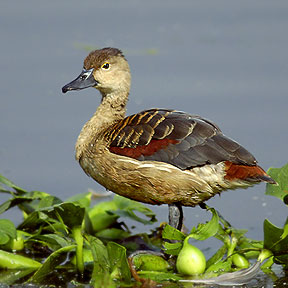 .
.
Field Characters: A small chestnut-coloured duck, confusable with no other of the same size. The shrill wheezy whistling notes, sea-sick, constantly uttered on the wing, and the feeble, flapping, rail-like flight are other clues to its identity. Sexes alike. Small flocks, on weedy tanks. Resident (presumably), and local migrant. Fairly common. Low country. Distributed outside Kerala is in Ceylon , all India , Burma , Malaysia , and the Indochinese countries. The birds are poor fliers, but walk and dive well. Their food consists of snails, worms, frogs, fish, in addition to shoots and grain.
Eggs: 7 to 12, milk-white becoming brown-stained during incubation.
Average size: 46.9X36.8 mm.
Common Teal
Local Name: Yeranda
Size: Of half grown domestic duck. Slightly larger than the Cotton Teal.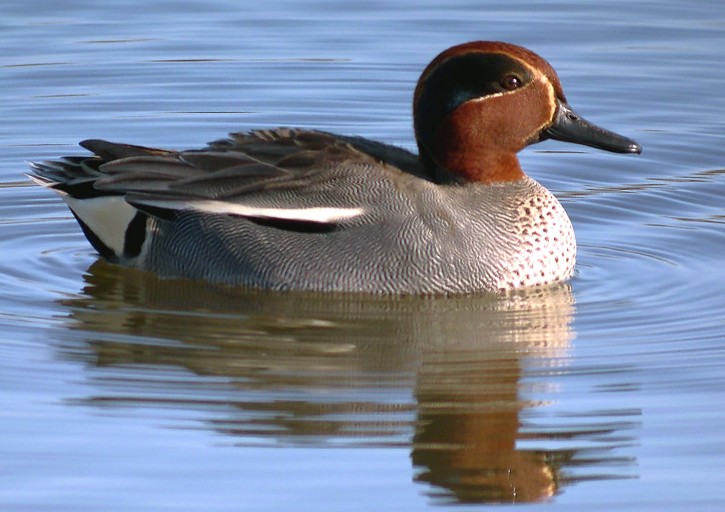
Field Characters: Male: penciled grayish, with chestnut head and a broad metallic green band running backward from in front of eye to nape, bordered above and below with whitish. A tricoloured wing-bar black, green and buff – particularly conspicuous in flight. Female: mottled dark and light brown, with pale underparts and black and distinctive green wing speculum. Flocks, at reedy shallow tanks. Winter visitor. Not common. Distributed outside Kerala is in Summer (breeding): the Palaearctic Region. Winter: N. Africa and practically all South Asia, including India, Burma and Ceylon . Its food consists largely of vegetable matter.
Cotton Teal
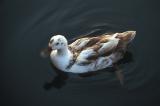 Local Name: Yeranda
Local Name: Yeranda
Size: Slightly larger than the Pigeon.
Field Characters: A diminutive wild duck, with white predomination in the plumage. Male in breeding dress: back glossy metallic brown with some glossy green on the wings. Face, neck and underparts white. Top of head and a narrow collar round base of neck blackish. In flight a broad white bar along the trailing edge of the wings is an arresting feature. Female duller and paler, with the collar diffuse and less defined. Non-breeding males resemble the female, but the white wing-bar is diagnostic, small flocks, on tanks. According to Ferguson (1904, JBNHS 16: 18 ) a winter visitor only, and never abundant. Distributed outside Kerala is in Ceylon , all India (excepting the arid NW. parts of Pakistan); Burma , Malaysia , S. China to Celebes.Another race is found in N. Australia . Their food consists of shoots and grain of wild and cultivated rice and other vegetable matter supplemented with insects, crustacea, worms.
Eggs: 6 to 12 , ivory white.
Average size: 43.1X32.9
Blacke Lackwinged Kite
Local Name: Velli-eriyan.
Size: About that of the House Crow.
Field Characters: A small ashy grey and white hawk with a black line above the eyes and black patches .jpg) on the shoulders, especially prominent while atrest. The black tips of the closed wings(primaries) extend beyond the short square-cut white tail. In bad light the head-on silhouette of the flying bird is very like a flying fox's. Sexes alike. Singly, in open grass jungle. Believed by Ferguson (1904, JBNHS 15:670) to be only a winter visitor. Uncommon. Distributed outside Kerala is in Patchily nearly all over India and Ceylon . Subject to local movement.Perches on a tree-top or pole in open country surveying the ground and puncing upon lizards , grasshoppers or filed-mice. It is largely crepuscular and also markedly parochial, keeping to the same locality and lookout posts day after day. His flight is sluggish with the wing-beats reminiscent of a crow's; it is punctuated by short spurts of sailing. The bird frequently hovers in the air like a kestrel to espy creeping prey, parachuting down in steps for a closer view-wings open and upraised back to back- and pouncing on the quarry. It is exceptionally silent.
on the shoulders, especially prominent while atrest. The black tips of the closed wings(primaries) extend beyond the short square-cut white tail. In bad light the head-on silhouette of the flying bird is very like a flying fox's. Sexes alike. Singly, in open grass jungle. Believed by Ferguson (1904, JBNHS 15:670) to be only a winter visitor. Uncommon. Distributed outside Kerala is in Patchily nearly all over India and Ceylon . Subject to local movement.Perches on a tree-top or pole in open country surveying the ground and puncing upon lizards , grasshoppers or filed-mice. It is largely crepuscular and also markedly parochial, keeping to the same locality and lookout posts day after day. His flight is sluggish with the wing-beats reminiscent of a crow's; it is punctuated by short spurts of sailing. The bird frequently hovers in the air like a kestrel to espy creeping prey, parachuting down in steps for a closer view-wings open and upraised back to back- and pouncing on the quarry. It is exceptionally silent.
Eggs: 3 or 4, yellowish white, usually densely blotched with brownish red.
Average size: 39.3x 30.9mm
Crested Honey Buzzard
Local Name: Ten kotichi
Size: About that of the Pariah Kite
Field Characters: Extremely variable in coloration. One of the commonest phases is greyish brown above, pale brown below narrowly cross-barred with white. A short blackish nuchal crest of a few elongated feathers noticeable in profile when slightly raised. In overhead flight rather like the Shortr-toed Eagle, but slenderer: underside of wings silvery grey with dark markings; tail grayish with two broad blackish cross-bands. The longer neck and slenderer head readily distinguish it from the Short-toed Eagle. Sexes alike. Singly, in wooded country. Winter visitor. Frequents deciduous and semi-evergreen forest. Distributed outside Kerala is Practically in India, Ceylon and Burma . In many areas found only as a local migrant.
The species, with other races, ranges from India to Siberia and Japan, including Malaysia and the Phillippines on the south. Lives largely on honey and larvae of bees extracted from combs on forest trees. The thick covering of short scale-like feathers on its face is evidently a protection against stings. It also eats small mammals, reptiles and birds and is particularly destructive to the eggs and nestlings of the last.
Eggs: usually 2, very variable in coloration: white to pale salmon-buff, freckled, mottled or blotched with some shade of chestnut-brown.
Average size: 52.8X42.8 mm
Common Parian Kite
Local Name: Chakki-parundu
Size: Smaller than the Vulture (about 24 inches, or 60 cm.)
Field Characters: A large familiar brown hawk distinguished from all similar birds by the forked tail, particularly conspicuous in flight. Sexes alike. Singly or gregariously, about human habitations. Resident. Common, low country, and sparingly in the hills up to about 5000 ft. (1500 m.); occasionally higher. It is found in All India, Burma and Ceylon . A scavenger, largely commensal on man, living mostly on garbage and offal. It is an inveterate robber of young chickens, especially when feeding its nest-young, and becomes a serious nuisance to poultry keepers. Also hawks flying termites in the air.
Eggs: 2 to 4 , dirty or pinkish white more or less spotted and blotched with reddish brown.
Average size: 52.7X42.7 mm.
Brahminy Kite
Local Name: Garudan, Krishna- parundu.
Size: That of the Pariah Kite.
Field Characters: A handsome rusty red or deep chestnut hawk with white head, neck and breast. Abdomen brown. Immature birds easily confused with the buzzard (Buteo). Under aspect of open wings greyish with a reddish tinge; in immature birds patchy as in the buzzard. Sexes alike. Singly, in the neighbourhood of water-streams, tanks, inundated paddy fields, seashore. Resident. Common. Low country, and occasionally to about 3000 ft. (900 m). It is found in the entire Indian Union, both Pakistans (excepting the north-western frontier districts), and Ceylon .Largely a scavenger, picking up bits of floating garbage from the surface of water. Further inland it is met more commonly during the monsoon when rain-filled puddles and flooded rive-fields supply an abundance of frogs and land crabs. Small fish and snakes are also eaten. The call is a harsh, wheezy squeal.
Eggs: Normally two, greyish white feebly speckled and blotched with pale dingy reddish brown.
Average size: 50.7x40.2 mm.
Black Eagle
Local Name: Karimparundu
Size: Larger than the Pariah Kite.
Field Characters: A large black eagle the tips of whose wings when at rest reach the end of the tail. In overhead flight the black plumage, narrowly grey-barred tail-longer than in most eagles – and the bright c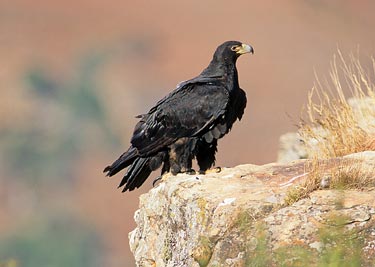 hrome yellow feet are diagnostic. The dark underside of the wing contrasting with a pale patch on the primaries, the bright yellow cere and a white patch under the eye – visible at close range – confirm its identity. When sailing the broad wings are held above the line of the back in a wide V, and end in upturned ‘splayed fingers' as in a vulture. Sexes alike. Singly, on forested hills. Resident. Fairly common, but not abundant. Evergreen and moist deciduous biotope. Foothills, and upto the highest elevations. Forested ravines or shoals, interspersed with open grassy spurs and hillsides, are its favourite haunts. Distributed outside Kerala is in Ceylon ; the Western Ghats country north to the Tapti River , including the Nilgiris, Palnis and associated hills. Also the Shevaroys. The Satpuras and other hills in Madhya Pradesh, Andhra, Bihar , Orissa, W. Bengal and E. Pakistan . The Himalayas from W. Pakistan to eastern Assam . Burma ; Thailand ; Malaysia to Celebes . Its food consists of frogs, lizards and large insects. Birds, even of the SIZE of junglefowl, are often killed and nests are habitually robbed of their contents, both eggs and young.
hrome yellow feet are diagnostic. The dark underside of the wing contrasting with a pale patch on the primaries, the bright yellow cere and a white patch under the eye – visible at close range – confirm its identity. When sailing the broad wings are held above the line of the back in a wide V, and end in upturned ‘splayed fingers' as in a vulture. Sexes alike. Singly, on forested hills. Resident. Fairly common, but not abundant. Evergreen and moist deciduous biotope. Foothills, and upto the highest elevations. Forested ravines or shoals, interspersed with open grassy spurs and hillsides, are its favourite haunts. Distributed outside Kerala is in Ceylon ; the Western Ghats country north to the Tapti River , including the Nilgiris, Palnis and associated hills. Also the Shevaroys. The Satpuras and other hills in Madhya Pradesh, Andhra, Bihar , Orissa, W. Bengal and E. Pakistan . The Himalayas from W. Pakistan to eastern Assam . Burma ; Thailand ; Malaysia to Celebes . Its food consists of frogs, lizards and large insects. Birds, even of the SIZE of junglefowl, are often killed and nests are habitually robbed of their contents, both eggs and young.
Eggs: Normally a singleton, handsome, whitish to pinkish in ground colour densely and finely stippled with pale brick-red.
Average size: 62.7x49.9 mm.
Whitebreasted Waterhen
Local Name: Kula-kozhi
Size: About that of the Partridge
Field Characters: A familiar slaty grey, stub-tailed, skulking marsh bird with prominent white face,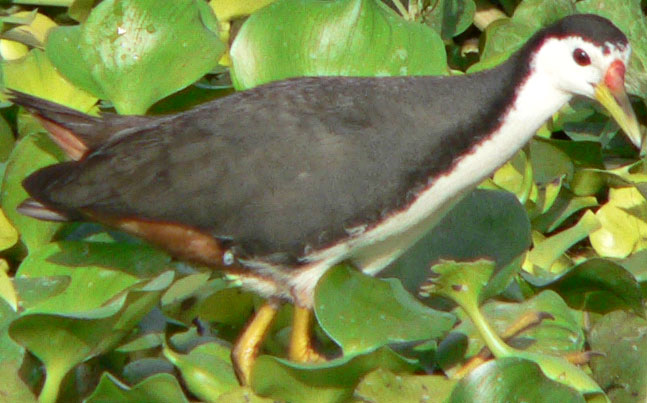 supercilia, throat, breast and middle of abdomen, and rusty red under the tail. Sexes alike. Singly, about thickets on waterlogged ground. Resident. Fairly common. Chiefly low country but upto at least 3000 ft. (c. 900 m.) – Periyar Lake environs. Affects Pandanus brakes and marginal vegetation in swamps and inundated paddy fields. Also the neighbourhood of homestead along the coastal backwaters. Distributed outside Kerala is in Ceylon and peninsular India north to about lat. 20 0 N. North India , Assam and Burma are inhabited by the race chinensis. Other races extend the species to Malaysia , southern China , the Philippines and Formosa .. Silent except during the monsoon months when breeding, when it becomes particularly noisy. Its food consisit of insects, worms, molluscs, grain and shoots of paddy and marsh plants.
supercilia, throat, breast and middle of abdomen, and rusty red under the tail. Sexes alike. Singly, about thickets on waterlogged ground. Resident. Fairly common. Chiefly low country but upto at least 3000 ft. (c. 900 m.) – Periyar Lake environs. Affects Pandanus brakes and marginal vegetation in swamps and inundated paddy fields. Also the neighbourhood of homestead along the coastal backwaters. Distributed outside Kerala is in Ceylon and peninsular India north to about lat. 20 0 N. North India , Assam and Burma are inhabited by the race chinensis. Other races extend the species to Malaysia , southern China , the Philippines and Formosa .. Silent except during the monsoon months when breeding, when it becomes particularly noisy. Its food consisit of insects, worms, molluscs, grain and shoots of paddy and marsh plants.
Eggs: 6 or 7, cream or pinkish white streaked and blotched with reddish brown.
Average size: 39.5X30.0mm
The Brozewinged Jacana
Local Name: Eetkili-kalam,Thamarakozhi
Size: About that of the Partridge.jpg)
A leggy swamp bird, something like the moorhen, with glossy black head and breast, metallic greenish bronze back and wings, and chestnut-red stub tail. A broad white stripe from the eye to the nape. Sexes alike. Young birds chiefly whitish, ruffoous and brown. The outstanding feature of the Jacanas-this species and the next is their absurdly elongated spider like toes. Resident. Not common, but frequent.Its food consists of seeds and shoots of water-plants, as well as insects and molluscs.
Eggs: Normally 4, very glossy and handsome, bronze-brown with an irregular network of dark brown scrawls.
Average size: 36.4x25.1mm. The female is polyandrous. The male incubates the eggs and looks after the young.
Pheasant-Tailed Jacana
Local Name: Thamara –Kozhi,Valan thamarakozhi
Size: About that of the Partdirge, excluding the long sickle-shaped tail .jpg)
In breeding plumage a striking white and chocolate-brown rail-like marsh bird with enormous spidery feet and sickle shaped ‘pheasant' tail. Face and foreneck white; hindneck pale golden yellow. In flight the large amount of white in the plumage and the pointed downcurved tail are pointers to its identity. In non-breeding plumage chiefly pale brown and white, with a black neckle on upper breast, and minus the long tail. Sexes alike. Resident, presumably. They are distributed outside Kerala in Ceylon and practically all India. , Assam and Murma.Eastward to Malaysia ,S.China and Philippines .
Travancore Pied Kingfisher
Local Name: Pulli-ponman, Pulli meenkothi
Size: Between the Myna and the Pigeon 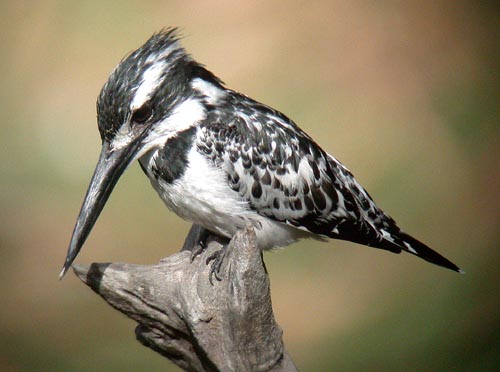
A speckled and barred black-and-white kingfisher with the typical stout dagger-shaped bill(black). Forehead, crown and nuchal crest black,finely streaked with white. Supercilium and collar on hindneck white. A broad black streak through eye to ear-coverts. Underparts white with a double black gorget across breast in the male. In the female the lower gorget is wanting and the upper broken in the middle. Resident. Common. Low country. Keeps to the coastal backwaters and to the larger placid streams with deep rock pools here and there, north to about Kozhikode . Nesting Season-evidently between November/December and March/April. Nest- a horizontal tunnel, 3 to 6 ft.(1 to 2 m) in length, excavated in the precipitous mud bank of a stream or river. It terminated in a widened egg-chamber, unlined but almost invariably littered with cast-up fish bones.
Eggs: 5 or 6, pure white, glossy, roundish ovals.
Average size: 29.9x21.4mm.
Chestnut-Headed Bee-Eater
Local Name: Veli-Tatta,Chemban velitatta
Size: About the same as the Small Green Bee-eater (=Sparrow)
Like the small Green Bee-eater but lacking the elongated pin-feathers in tail and with the whole crown, hindneck and back chestnut. Rump pale blue. Chin, Throat and sides of neck pale yellow; a black-bordered chestnut gorget across lower throat. Sexes alike.Resident. Decidous and semi-evergreen biotope. It is also found in Ceylon, south-west India north to about Belgaum; Himalayan tarai and bhabar form Dehra Dun to E.Assam, Orissa; E.Bengal. Rare in the central and eatern parts of the peninsula. An endemic race andamanensis in the Andaman Is.Neasting:Season-February/March and perhaps later. Nest-a tunnel dug in a sandy bank of a nullah or stream in well wooded country.
Eggs: 4 or 5, pure white roundish ovals with a glossy texture.
Average size: 21.7x19.0mm.
Malabar Grey Hornbill
Local Name: Kozhi-Vezhambal
Size: About that of the Kite
.jpg) A plain brownish slaty-grey hornbill without any casque on its bill. Wing-quills and tail black, the latter with broad white tips to the two central pairs of feathers. Throat and breast streaked with whitish. Sexes almost alike (see colours of bill). Resident. Common. Affects evergreen and moist decisuous biotope from the low country (eg. Thattakad, c.200ft., or 60m) to about 4000ft(1200m) in the hills. Lofty shade-trees in cardamom shoals with a sprinkling of wild figs(Ficus) are favoaurite haunts). Goes about in parties of 5 or 6. Larger flocks congregate to feed on fruiting trees in the usual frugivorous company of green pigeons, grackles and others. Nesting: Season-January to early April, most eggs being found in February. Nest and nesting habits as of the familiy(see under Great Indian Hornbill).
A plain brownish slaty-grey hornbill without any casque on its bill. Wing-quills and tail black, the latter with broad white tips to the two central pairs of feathers. Throat and breast streaked with whitish. Sexes almost alike (see colours of bill). Resident. Common. Affects evergreen and moist decisuous biotope from the low country (eg. Thattakad, c.200ft., or 60m) to about 4000ft(1200m) in the hills. Lofty shade-trees in cardamom shoals with a sprinkling of wild figs(Ficus) are favoaurite haunts). Goes about in parties of 5 or 6. Larger flocks congregate to feed on fruiting trees in the usual frugivorous company of green pigeons, grackles and others. Nesting: Season-January to early April, most eggs being found in February. Nest and nesting habits as of the familiy(see under Great Indian Hornbill).
Eggs: Usually 3, sometimes 4, white but becoming discloured in incubation.
Average size: 41.4x30.0
Malabar Pied Hornbill
Local Name: Vezhambal,Ponden vezhambal
Size: Larger than the Grey Hornbill. Between the Kite and the Vulture.
Easily differentiated from the Great Indian Hornbill (next) by its smaller SIZE, black neck and white underparts. Tail white with the central pair of feathers black. Casque or helmet high, narrow and sharp-ridged, ending in a single point. Female like the male except in the coloration of the soft parts (see below). Noisy flocks, in lofty tree-tops. Resident. Uncommon. Affects evergreen and moist deciduous forest along the foot of the hills, e.g., Thattakad, Amarambalam (Malabar district). It is also found in Ceylon ; Western Ghats north to about Ratnagiri; the former Hyderabad state, Madhya Pradesh, Bihar , Orissa. Arboreal and mainly frugivorous.
Eggs: White in colour becoming brown-stained as incubation proceeds.
Average size: About 55X38 mm.
Great Indian Hornbill
Local Name: Malamuzhalkki (mountain – shaking), Vezhambal, Kompan vezhambal.
Size: About that of the Vulture.
A large pied bird with enormous, stout, yellow and black horn-shaped bill, surmounted by a cumbersome-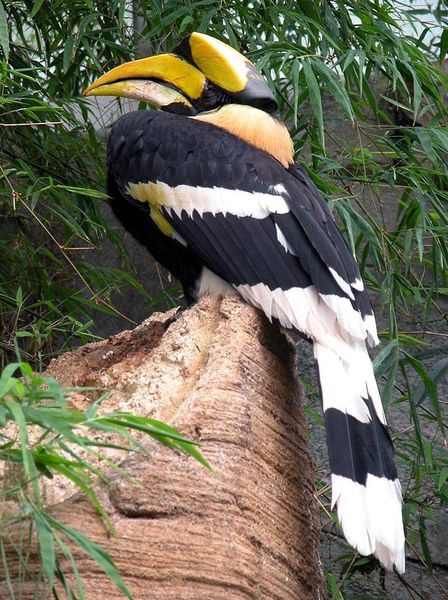 looking casque. Viewed from the front this is broadly U-shaped. Face black; neck and tail white, the last comparatively long and rounded and with a broad black subterminal band. Wings black with two white bars in each, especially conspicuous in flight. Back and underparts black. Lower abdomen, upper and under tail-coverts white. Sexes nearly alike. Pairs or parties, in tall trees, or in noisy flight over forest. Resident. Common in evergreen forest biotope. It is also found in Throughout the Western Ghats north to about Khandala; Himalayas from Kumaon to eastern Assam , and E. Pakistan . Usually met with in pairs or parties of 3 to 5. Diet largely frugivorous, but also eats small mammals, lizards and snakes. The birds have a regular time-schedule over fixed routes to and from their feeding and roosting places, which is followed punctually day after day. Their deep harsh grunts, roars or barks, and loud resonant call tok-tok, reverberate in the forest-clad valleys and are responsible for their Malayali name. The flight, slow and heavy, is accomplished by deliberate beats of the broad wings, the tips of the primaries upturned, and is punctuated by occasional short glides.Nesting Season – February, March, April. Nest – an unlined natural hollow in a large poon (Calophyllum tomentosum) or other forest tree, usually between 50 and 75 ft. (15 and 23 m.) from the ground. The same site is used year after year. The entrance is walled up with a plaster composed chiefly of the bird's dung, the flat sides of the bill serving as a trowel. Only a narrow slit is left through which the male feeds his mate while she is sitting on the eggs. The female moults her flight-feathers during this period of incarceration. After the young hatch out the wall is broken down; she releases herself and thereafter assists in foraging for the squabs. The wall is built up again for protection of the young till they are able to fly.
looking casque. Viewed from the front this is broadly U-shaped. Face black; neck and tail white, the last comparatively long and rounded and with a broad black subterminal band. Wings black with two white bars in each, especially conspicuous in flight. Back and underparts black. Lower abdomen, upper and under tail-coverts white. Sexes nearly alike. Pairs or parties, in tall trees, or in noisy flight over forest. Resident. Common in evergreen forest biotope. It is also found in Throughout the Western Ghats north to about Khandala; Himalayas from Kumaon to eastern Assam , and E. Pakistan . Usually met with in pairs or parties of 3 to 5. Diet largely frugivorous, but also eats small mammals, lizards and snakes. The birds have a regular time-schedule over fixed routes to and from their feeding and roosting places, which is followed punctually day after day. Their deep harsh grunts, roars or barks, and loud resonant call tok-tok, reverberate in the forest-clad valleys and are responsible for their Malayali name. The flight, slow and heavy, is accomplished by deliberate beats of the broad wings, the tips of the primaries upturned, and is punctuated by occasional short glides.Nesting Season – February, March, April. Nest – an unlined natural hollow in a large poon (Calophyllum tomentosum) or other forest tree, usually between 50 and 75 ft. (15 and 23 m.) from the ground. The same site is used year after year. The entrance is walled up with a plaster composed chiefly of the bird's dung, the flat sides of the bill serving as a trowel. Only a narrow slit is left through which the male feeds his mate while she is sitting on the eggs. The female moults her flight-feathers during this period of incarceration. After the young hatch out the wall is broken down; she releases herself and thereafter assists in foraging for the squabs. The wall is built up again for protection of the young till they are able to fly.
Eggs: 1 or 2, rarely 3, white when laid but soon becoming discoloured through contact with the wood.
Average size: 65.1X46.3 mm. (Fauna).
Malabar Crimsonthroated Barbet
Local Name: Alkili
Size: Same as the Coppersmith Barbet; slightly larger than the Sparrow.
Differs from the Coppersmith (nest) in having a patch below the eye, a spot on the cheek, and the chin, throat and foreneck crimson in addition the forehead and fore-crown. Upper breast black with crimson apical streaks. Sexes alike. Singly, pairs or loose parties, on fruiting trees in forest.Resident. Common but local. Foothills and up to about 4000ft; or 1200m. restricted to evergreen biotope It is also found in Western coastal India north to about Goa including Nilgiris, Coorg, Wayanad and W.Mysore.
Nesting:Season-January to March. Nest and eggs indistinguishable from those of the soppersmith.
Average sizeof eggs: 24.7x17.7mm.
Crimsonbrested or Coppersmith Barbet
Local Name: Chempukotti.
Size: Slightly larger and dumpier than the House Sparrow
A heavy-billed grass-green bird with yellow throat, crimson breast and forehead, and green-streaked yellow underparts. Short, square-cut tail appearing distinctly triangular in overhead flight. Sexes alike. Singly or loose parties , on banyan and papal trees in fruit. Resident. Fairly common. Deciduous low country, normally under about 500 ft(150m). Occasionally up to 1500ft, and exceptionally to 3500ft. affects lightly wooded terrain about cultivation, groves of trees near villages and wooded compounds in towns. It is also found in Ceylon and practically all India .Arboreal and frugivorous. When calling, the head is bobbed from side to side, producing a curious ventriloquistic effect. Combined with the assimilative coloration of the bird, this makes it difficult to locate the vocalist amongst the green foliage.
Nesting: Season-February to April. Nest-the usual hole in somerotten softwood branch, such as of a Coral or Drumstick tree.
Eggs: Usually 3, glossless pure white, unmarked.
Average size: 25.0x17.7mm.Both sexes share in excavating the nest-hole, incubation, and care of the young.
Malabar Great Black Woodpecker
Local Name: Kakka maramkoti
Size: About that of the House Crow.
A magnificent large black woodpecker with conspicuous white rump, and white underparts from breast down. Male with brilliant crimson forehead, crown, nuchal crest and cheeks. In female crimson confined to nape only. Singly or pairs, in large trees forest. Resident. Fairly common locally. Evergreen and moist deciduous biotope. Foothills and upto about 3500 ft. (1050 m). Caradamom shoals with their lofty natural shade-trees, well-shaded tea and coffee plantations, and secondary semi-evergreen jungle intermixed with bamboo are its favourite haunts. It is also found in The strip of country along the Western Ghats including the Nilgiris and Western Mysore , north to the Tapti River . Also obtained recently in eastern Madhya Pradesh (Salim Ali, 1951, JBNHS 49 : 787), so presumably extends along the Satpura mountain trend in the same way as the Heartpotted Woodpecker (q.v.). Absent in Ceylon . Its food consists largely of the grubs of wood-boring beetles and pupae of white ants.Nesting: Season – principally January to March. Nest – usually excavated in rotten tree-trunks at heights of 25 to 50 feet (7.5 to 15 m.) from the ground. The entrance-hole is about 6 inches, or 15 cm., in diameter, the hollow itself being about 2 feet (60 cm.) deep.
Eggs: Normally 2, sometimes 3 or 4,white broad ovals.
Average size: 35.5X23.5 mm.
Heartspotted woodpecker
Local Name: Pulli maramkoti
Size: Between the Sparrow and the Myna.
A dainty little black and buff woodpecker with short very slender neck and large crested head, and a curiously short and broad rounded tail. Male : Back black with conspicuous heart-shaped buff spots on the upper side of the wings. Rump buffy white. Chin, throat, sides of neck and base of hindneck buffy white. Underparts dark olive and black. Forhead, crown and crest black, the first two minutely speckled with white. Female : differs in having the forehead and anterior crown buffy white, and more buffy white on the wings. Widely separated pairs, in tree forest. Resident. Fairly common. Evergreen and moist deciduous biotope. It is also found in The Western Ghats to their northern most limit, near the Tapti River , including the Nilgiris, western Mysore , Kanara. Has also been recorded from Chanda, and obtained in eastern Madhya Pradesh and Orissa, indicating that its distribution stretches unbroken across the peninsula along the Satpura mountain trend. Beyond, it occurs in Assam , Burma , Thailand , Annam , Cochin , China and Malaysia . Absent in Ceylon.Typical. Its call is a characteristic pleasant trill consisting of a quick-repeated twee, twee-sharp but loud-up to 7 or 8 times.
Nesting : Season – November to April. Nest – a hole made in a dead branch usually at great heights (uptp 40 ft. or 12 m.) from the ground.
Eggs: 3, white, unmarked.
Average size: 23.5X18.6 mm.
Blackbacked woodpecker
Local Name: Maramkoti
Crown and crest crimson in male; golden yellow in female. Back and tail black. Sides of hindneck and middle of upper back white, joining to form a prominent white V. Upperparts of wings golden olive. Cheeks, chin, throat and foreneck fulvous white with five narrow longitudinal black streaks. When only the head and neck of the bird are visible, this striped pattern on the throat is diagnostic. Underparts buffy white, the feathers edged with black and forming a bold scaly pattern on the breast. Singly or pairs, in open tree forest.resident.uncommon and local. Decidous and semi evergreen biotope. It is also found in lower Nilgiris, Mysore and greater part sof peninsular and continental India northto the Himalayan foothills. Nesting :season season – December to March. Nes- the usual hole cut into the stem of a tree, 8 to 20 ft from the ground.
Eggs: Nearly always a singleton, white and unmarked.
Average size: 31.2 X24.1mm
Indian Oriole
Local Name: Manjakkili
Bright golden yellow with black in wings and tail, and a conspicuous black streak from the lores backward through the eye. Female and young male duller and greener, with underparts whiter and streaked with dull brown. Singly or pairs, in wooded country. Arboreal streaked with dull brown. Singly or pairs, in wooded country. Arboreal. Partly resident largly local migrant. Frequents open secondary forest either decxidous or with a mixture of evergreen. It is also found in all India from Kashmir to Kanayakuamri and from Baluchistan to Bengal . Not cylone. Entirely arboreal. Keeps to the foliage canopy of tree but occasionally descends to low bushes such as lantana when in ripe fruit.
Bladck Drongo
Local Name: Kakka-tampuratti,Anaranchi
A glossy jet black bird with long deeply forked tail. Sexes alike. Resident. Common. Deciduous low country under 500 ft. (c. 150 m) Affects open fallow and grazing land, and compounds in towns and villages. Very partial to the jack-fruit, cashew and coconut gardens surrounding homesteads along the backwaters, and the dyked paddy cultivation in this neighbourhood. It is also found in Peninsular India south .jpg) of the Indo-Gangetic plain. Northern India and the Lower Himalayas together with Assam are occupied by the race albirictus, and Ceylon by minor.Single birds commonly seen perched on telegraph wires, dead trees, fence-posts and the like keeping a sharp look-out for grasshoppers and other insects and pouncing on them on the ground or capturing them in the air. If too large to be swallowed entire, the victim is held under foot and torn to pieces with the sharp hook-tipped bill. Their diet is entirely insectivorous; they do considerable good to agriculture by the large quantities of injurious pests they destroy. They have a number of harsh challenging calls, some closely resembling those of Shikra hawk. The birds become particularly noisy at the breeding season, when they frequently indulge in scolding duets, trios and quartets. Nesting: Season – March to June/July. Nest – a flimsy-bottomed cup of fine twigs, grasses and fibres loosely cemented together with cobwebs. Placed in a fork, usually near the extremity of a horizontal branch, or up in the head of a palm at the base of a leaf stalk, 20 to 30 ft. (c. 6 to 9 m) from the ground. A tree standing by itself in the midst of open cultivation and commanding a good view of the surroundings is preferred.
of the Indo-Gangetic plain. Northern India and the Lower Himalayas together with Assam are occupied by the race albirictus, and Ceylon by minor.Single birds commonly seen perched on telegraph wires, dead trees, fence-posts and the like keeping a sharp look-out for grasshoppers and other insects and pouncing on them on the ground or capturing them in the air. If too large to be swallowed entire, the victim is held under foot and torn to pieces with the sharp hook-tipped bill. Their diet is entirely insectivorous; they do considerable good to agriculture by the large quantities of injurious pests they destroy. They have a number of harsh challenging calls, some closely resembling those of Shikra hawk. The birds become particularly noisy at the breeding season, when they frequently indulge in scolding duets, trios and quartets. Nesting: Season – March to June/July. Nest – a flimsy-bottomed cup of fine twigs, grasses and fibres loosely cemented together with cobwebs. Placed in a fork, usually near the extremity of a horizontal branch, or up in the head of a palm at the base of a leaf stalk, 20 to 30 ft. (c. 6 to 9 m) from the ground. A tree standing by itself in the midst of open cultivation and commanding a good view of the surroundings is preferred.
Eggs: 3 to 5, variable in colour and markings, the most common type being whitish with brownish red spots.
Average size: 25.5X19.0 mm. (Fauna).